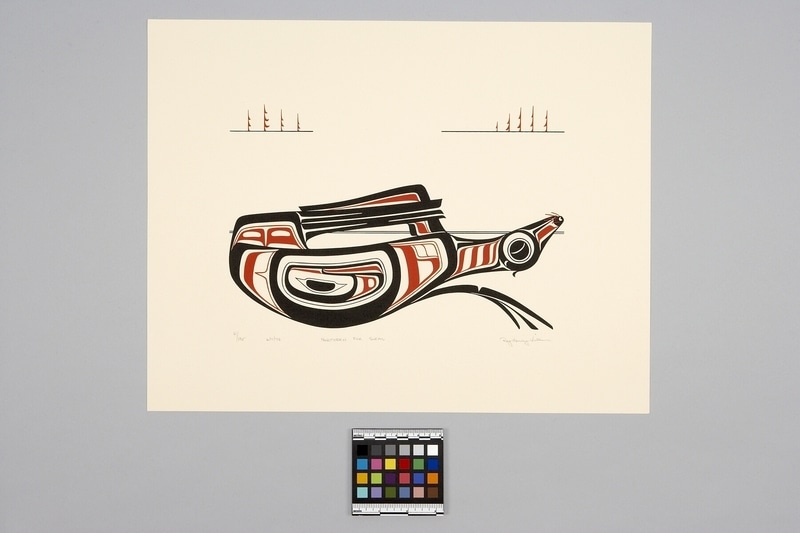Northern Fur Seal Item Number: Nb7.292 from the MOA: University of British Columbia

Description
Stylized configurative animal image in black form line with orange-brown detail. Animal lies on its back with flipper-like appendages overlapped at the top. Large black ovoid body with a flattened long edge at the top. Upside down salmon-trout head at the centre outlined by black with an orange-brown split u and s-shapes to the sides. At the left top, there is black u form with two orange-brown u forms inside, each of which has an ovoid at the top all outlined with a u-shaped orange-brown line. Flipper-like, black appendage to the right is crossing the second which starts at the right end of the u form. Neck stretches out to the right with four evenly spaced orange-brown s-shapes along the interior. Large circular, black eye is followed by a tapering snout with an orange-brown u form and five horizontal, red whiskers pointing to the left side. Sweeping black line from the ovoid to the right bottom divides into three. Two close, parallel black lines run horizontally behind the animal. Two segment, discontinuous black horizontal line across the top has four and five orange-brown tree-like vertical lines, respectively. Pencil inscription across the bottom edge '61/195 3/7/78 NORTHERN FUR SEAL Roy Henry Vickers'. The print is on a horizontally rectangular, light white-brown paper stock.
History Of Use
Northwest Coast serigraphs are a contemporary art form, deriving from early 20th century drawings of traditional crest and decorative designs, commissioned by anthropologists and undertaken by artists such as Charles Edenshaw. Residential schools reinforced the medium, while discouraging the use of traditional themes. An important series of traditional designs in coloured pencil and watercolour were done by Mungo Martin for UBC in 1949-50. The 1960's saw the rapid growth of prints, first in unlimited poster editions, and later with the establishment of the Gitanmaax School of Northwest Coast Indian Art at 'Ksan (1967), and of the Northwest Coast Indian Artists Guild (1977), limited edition art runs became the standard. Northwest Coast silkscreen prints are part of the mainstream art market, as well as, functioning within the native context as potlatch gifts, and commemorative prints. Although, there are distinctive regional styles, individual artists may work in several styles, or apply unique themes and variations to specific works.
Cultural Context
contemporary art
Item History
- Made by Roy Henry Vickers (Maker) in British Columbia, Canada during July 1978
- Owned by Norman Sandomirsky and Tobie Sandomirsky before June 27, 1984
- Received from Norman Sandomirsky (Donor) and Tobie Sandomirsky (Donor) on June 27, 1984
What
- Name
- Northern Fur Seal
- Identification Number
- Nb7.292
- Type of Item
- Manufacturing Technique
- silkscreened
- Overall
- height 35.6 cm, width 45.6 cm, depth 0.1 cm
Who
- Culture
- Tsimshian
- Creator
- Roy Henry Vickers (Maker)
- Previous Owner
- Norman Sandomirsky and Tobie Sandomirsky
- Received from
- Norman Sandomirsky (Donor) and Tobie Sandomirsky (Donor)
Where
- Holding Institution
- MOA: University of British Columbia
- Made in
- British Columbia, Canada
When
- Creation Date
- during July 1978
- Ownership Date
- before June 27, 1984
- Acquisition Date
- on June 27, 1984
Other
- Item Classes
- works on paper
- Condition
- good
- Accession Number
- 0979/0013